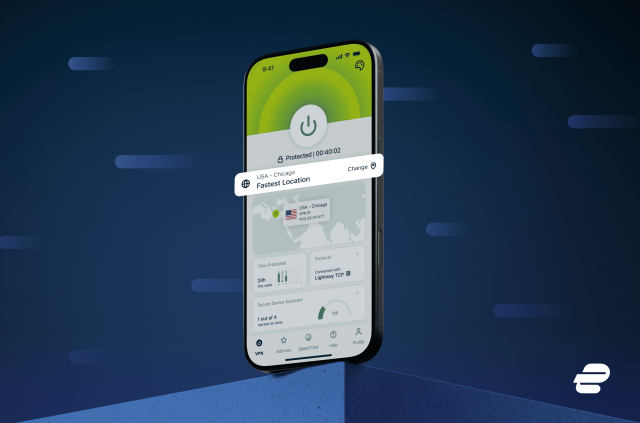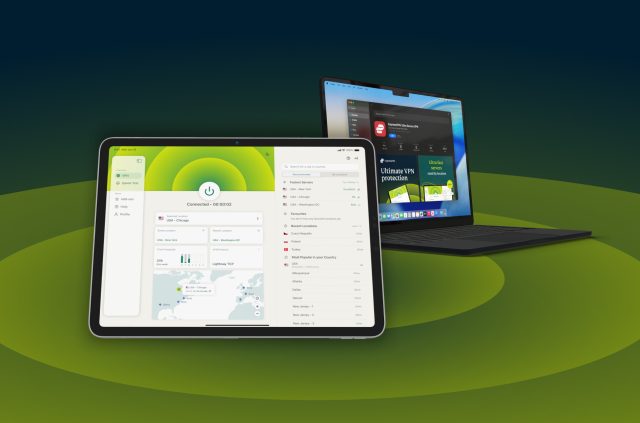From charging phones to mining Bitcoins: The energy use of everything

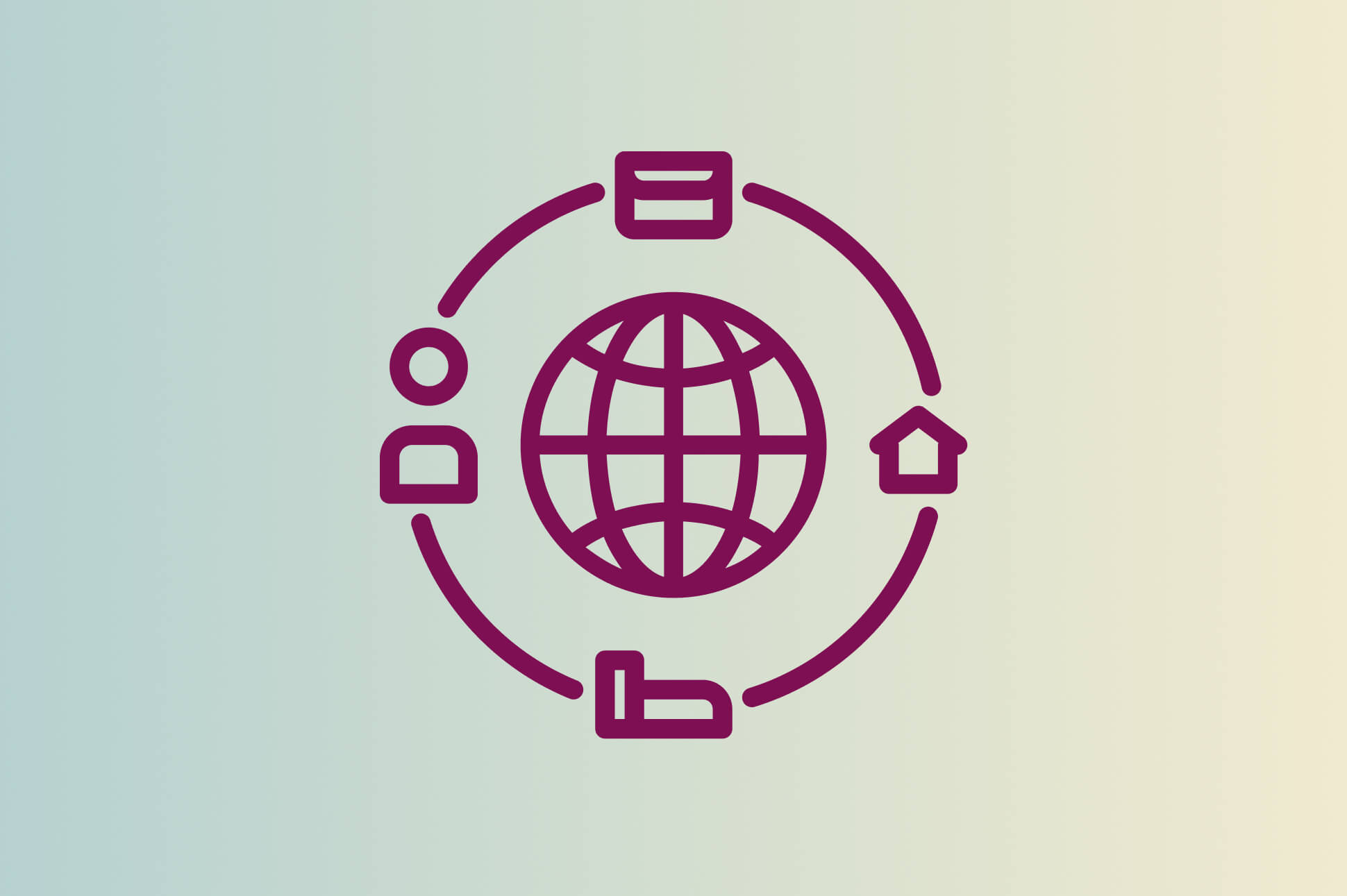
- This World Environment Day, on June 5, we examine everyday energy use through appliances and digital tech.
. - Some of the biggest energy suckers in our homes include heating and cooling systems, appliances, and lighting. We break down monthly costs.
.
- You could charge your phone for 1,000 years with the energy it takes to transact a single Bitcoin.
.
- Conserve energy by using a VR headset instead of a high-performance laptop, and optimize your gameplay and reduce lag with a gaming VPN.
.
- Global YouTube watching expends so much energy that turning it off for a week could power some small countries for a year.
From the moment we wake up and reach for our phones to the last show we binge-watch before going to bed, we’re constantly consuming energy. But have you ever stopped and considered the environmental impact of each of these actions?
Whether it's working at a computer all day, driving a car, flying in a plane, or even mining a single Bitcoin, these activities all require some form of power. And these actions add up.
Energy consumption is one of the major contributors to climate change. Burning fossil fuels such as coal, oil, and natural gas to generate electricity, power our vehicles, or heat our homes releases carbon dioxide (CO2) and other greenhouse gases into the atmosphere—which are widely considered to be contributing to climate change.
As inhabitants of this planet, we have a responsibility to protect it. As we approach World Environmental Day on June 5, it’s the right time to recognize our role in energy conservation and explore ways we can reduce our carbon footprint.
To help achieve this, we take a closer look at the everyday appliances and activities that consume the most energy in our daily lives and find small changes that can make a big impact.
How much energy is the tech in your home using (and how much is it costing you)?
If you thought that simply turning off appliances was enough to save energy, think again. According to recent research, today's connected homes are more power-hungry than ever, thanks to a plethora of devices that are always switched on at the wall or left running when not in use.
From smart TVs to game consoles, media servers to external hard drives, there are more ways than ever for your home to be racking up your energy costs. But before you rush to turn everything off, remember that some devices need to be left on for security purposes (like CCTV or your VPN) or continuous service (such as your refrigerator and freezer).
So, how can you strike a balance between convenience and energy conservation? It all starts with understanding just how much power your connected home is consuming, so you can make informed decisions about when and what to switch off.
In the infographic below, we break down the energy use of each item in a typical American household per month, along with the cost associated with it:

General
| Appliance | Estimated Power Consumption Range/hour | Estimated energy cost/hour (USD) | Length of use per day | Estimated Power Consumption Range/month | Estimated energy cost/month (USD) |
| Portable heater (1500W) | 1.5 kWh | $0.21 | 2 hours | 90 kWh | $12.6 |
| Air conditioner (240V) | 1.8 kWh | $0.25 | 4 hours | 216 kWh | $30.24 |
| Pedestal fan | 0.03 kWh | Less than $0.01 | 8 hours | 7.2 kWh | $1 |
| Ceiling fan | 0.05 kWh | Less than $0.01 | 6 hours | 9 kWh | $1.26 |
| Incandescent light bulbs (60W) | 0.75 kWh | $0.11 | 8 hours | 18.3 kWh | $2.5 |
| Clock | 0.1 kWh | $0.01 | Continuously | 7.2 kWh | $1 |
General home appliances that use the most energy
-
Heaters
Heating requires significant energy to raise the temperature of large volumes of air, and in poorly insulated homes, a lot of that heat escapes, forcing the heater to work even harder. Furthermore, many older heaters are inefficient, converting only a fraction of their fuel into usable heat. The result is a big chunk of your energy bill dedicated to staying warm.
2. Air conditioners
Not all air conditioners are created equal. Upgrading to newer, energy-efficient models with features like inverter technology can significantly reduce your energy consumption. Use eco mode if it’s available, and keep the air filter clean. Also keep in mind that the room size should determine how powerful your AC unit is; a small room doesn’t need a high wattage machine.
Bathroom
| Appliance | Estimated Power Consumption Range/hour | Estimated energy cost/hour | Length of use per day | Estimated Power Consumption Range/month | Estimated energy cost/month (USD) |
| Electric water heater | 0.52 kWh | $0.07 | 3 hours | 46.8 kWh | $6.50 |
| Electric toothbrush | 0.003 kWh | Less than $0.01 | 5 mins | 0.007 kWh | $0.01 |
| Hair dryer | 1.5 kWh | $0.21 | 20 mins | 13.5 kWh | $1.89 |
| Curling iron | 0.15 kWh | $0.02 | 10 mins | 0.72 kWh | $0.10 |
Bathroom appliances that use the most energy
-
Hot water heater
It takes a lot of power to raise the temperature of a large volume of liquid, and hot water heaters are kept on to keep the tank at your desired temperature, even when not actively used. This constant background heating, known as standby loss, contributes heavily to their energy consumption. Upgrading to an energy-efficient model or exploring alternative hot water solutions like heat pumps can be beneficial.
2. Hairdryer
A hairdryer can quickly increase electricity costs depending on its wattage and usage frequency. Using lower heat settings and air-drying whenever possible can make a big difference. Focus on quick blasts of air while moving the nozzle constantly whenever using a hairdryer.
3. Heated floors
While the cozy comfort of heated floors might seem like a luxury, their energy use can be significant. Unlike traditional space heaters that focus warmth in specific areas, heated floors attempt to raise the temperature of the entire floor surface. A lack of insulation is a major enemy of any heating system. Prioritizing home insulation significantly reduces heat loss, lessening the workload on your heated floors. Sealing air leaks around windows, doors, and other openings further traps warmth inside.
Bedroom
| Appliance | Estimated Power Consumption Range/hour | Estimated energy cost/hour | Length of use per day | Estimated Power Consumption Range/month | Estimated energy cost/month (USD) |
| Electric blanket: Double/Queen | 0.09 kWh | $0.01 | 3 hours | 8.1 kWh | $1.10 |
| Night light (4W) | 0.12 kWh | $0.02 | 10 hours | 36 kWh | $5.04 |
| Smartphone charger | 0.001 kWh | Less than $0.01 | Continuously | 0.15kWh | $0.02 |
| Radio alarm | 0.008 kWh | Less than $0.01 | Continuously | 5.8 kWh | $0.8 |
Bedroom appliances that use the most energy
-
Nightlights
While nightlights provide comfort and safety, they stay on for long hours. However, it’s not an issue if you use LED lights. LEDs use up to 90% less energy than traditional bulbs and have a significantly longer lifespan, making them a cost-effective choice in the long run.
2. Heated blankets
Heated blankets work by directly heating the fabric using embedded wires using significant energy, especially if you crank up the heat setting or leave the blanket running all night. The best way to reduce the cost created by a heated blanket is to simply stop using it and dress more warmly or use more blankets.
However, if you can’t live without your heated blanket, consider investing in one with a timer or an automatic shut-off feature. This allows you to program it to operate only for a specific duration, preventing unnecessary heating after you drift off to sleep. Alternatively, if you’ve got an old version, consider replacing it with a new, energy-efficient one. Look for blankets with automatic temperature adjustment and better insulation to minimize energy waste.
Kitchen
| Appliance | Estimated Power Consumption Range/hour | Estimated energy cost/hour | Length of use per day | Estimated Power Consumption Range/month | Estimated energy cost/month (USD) |
| Oven | 2.3 kWh | $0.32 | 30 minutes | 34.5 kWh | $4.83 |
| Stovetop | 1.5 kWh | $0.21 | 30 minutes | 22.5 kWh | $3.15 |
| Microwave | 1.44 kWh (0.12 kWh per 5 mins) | $0.12 ($0.02 per 5 min) | 15 minutes | 10.8 kWh | $1.5 |
| Kettle | 0.11 kWh | $0.02 | 10 minutes | 0.5 kWh | $0.07 |
| Coffee maker/warmer on | 0.4 kWh per hour (0.12 kWh per brew) | $0.05 ($0.02 per brew) | 1 hour | 9.6 kWh | $1.34 |
| Dishwasher (normal cycle not including hot water) | 1.1 kWh | $0.15 | 2 hour-load | 65.1 kWh | $9.11 |
| Toaster oven | 0.75 kWh | $0.10 | 5 minutes | 1.87 kWh | $0.26 |
| Refrigerator + freezer (17 cu. ft.) | 0.04 kWh | Less than $0.1 | Continuous | 35 kWh | $4.9 |
| Air fryer (1500W) | 1.5 kWh | $0.21 | 20 minutes | 14.9 kWh | $2.09 |
Kitchen appliances that use the most energy
-
Oven
Like any other appliance, age affects an oven's energy efficiency. Ovens need a high-wattage to reach your desired temperature. Older models often utilize outdated technology, converting only a fraction of their consumed energy into actual heat. Even when baking isn't on the agenda, some ovens, especially older ones, can sneakily draw standby power through poorly insulated transformers. This "phantom" power, though seemingly small, can contribute to wasted energy over time. Furthermore, worn-out seals around the oven door can leak heat, forcing the heating element to work even harder and consume more energy to maintain the desired temperature.
2. Refrigerator
Fridges run continuously, battling thermodynamics to keep your food chilled, and that constant operation demands significant energy. The size, age, and efficiency of your fridge also play a role, with older models or large units consuming more than smaller, newer models. Frequent door openings, keeping the thermostat set unnecessarily low, and overfilling the fridge can all contribute to its energy use.
3. Stovetops
Electric stovetops use heating elements beneath the cooktop surface to directly generate heat. These elements often have different wattages, with larger burners consuming more energy than smaller ones. The total energy consumption also depends on how long you use the burners and in what settings.
Gas stovetops burn gas to generate heat, which directly heats the cookware. While gas can be slightly more efficient than electric in some cases, leaks or inefficient burners can negate that advantage. Additionally, simmering on gas can be less efficient than on electric due to the constant flame.
For stovetops, being energy efficient is all about being careful with your usage. The more you use your stovetop, the more energy it'll consume. Planning meals and batch cooking can reduce usage frequency. Using the right size pot or pan for your burner ensures efficient heat transfer and prevents energy waste. Mismatched sizes mean wasted heat or undercooked food.
Laundry room
| Appliance | Estimated Power Consumption Range/hour | Estimated energy cost/hour | Length of use per day | Estimated Power Consumption Range/month | Estimated energy cost/month (USD) |
| Clothes dryer | 3 kWh | $0.5 | Twice a week | 25.5 kWh | $3.57 |
| Conventional washing machine | 2.3 kWh | $0.32 | Twice a week | 19.5 kWh | $2.73 |
| Vacuum cleaner | 0.75 kWh | $0.10 | 2 hours per week | 4.8 kWh | $0.67 |
| Robot vacuum cleaner | 0.007 kWh | Less than $0.01 | 45 minutes | 0.15 kWh | $0.02 |
| Iron | 1.08 kWh | $0.15 | 40 minutes per week | 2.8 kWh | $0.4 |
Laundry appliances that use the most energy
-
Dryers
Dryers extract water from your clothes using intense heat, a process demanding significant energy, especially in older models or those with extended drying cycles. The bigger the load or the higher the heat setting, the more power is used. When weather and resources permit, air-drying your clothes is the ultimate energy-saver. Your clothes will also last longer without the onslaught of tumbling and heat. Otherwise, lowering your dryer temperature by just a few degrees can make a difference. Opt for delicate or low-heat settings if it’s still getting the job done.
2. Washing machine
One of the reasons washing machines use so much electricity is because they do several things at once, heating water, agitating clothes, and pumping water, all of which demand significant energy. To reduce your washing machine’s power consumption, opt for cold water washing. It consumes significantly less energy than hot water cycles and often cleans just as effectively.
3. Vacuum cleaner
Older vacuums often have inefficient motors, converting much of their electricity into heat and noise instead of powerful suction. Apart from upgrading to a newer model, it helps slightly to unplug your vacuum cleaner to avoid “standby” power consumption. Of course, using alternatives like brooms or dust mops are a surefire way to lower your energy bill.
Living room
| Appliance | Estimated Power Consumption Range/hour | Estimated energy cost/hour | Length of use per day | Estimated Power Consumption Range/month | Estimated energy cost/month (USD) |
| LED TV (4k UHD) | 40”-50”: 0.071 kWh | Less than $0.01 | 3 hours | (Average): 2.8 kWh | $0.40 |
| Cable box (plugged in) | 0.01 kWh | Less than $0.01 | 3 hours | 0.9kWh | $0.14 |
| Streaming video player (Roku) | 0.002 kWh | Less than $0.01 | 3 hours | 0.18 kWh | $0.02 |
| Gaming console | 0.07 kWh | Less than $0.01 | 2 hours | 4.2 kWh | $0.58 |
| Speakers (25 Watts x 2) | 0.05 kWh | Less than $0.01 | 3 hours | 4.5 kWh | $0.63 |
| Stereo | 0.05 kWh | Less than $0.01 | 2 hours | 3 kWh | $0.42 |
| Radio/CD player | 0.02 kWh | Less than $0.01 | 1 hour 30 minutes | 0.9 kWh | $0.12 |
| Free-standing halogen luminaire | 0.02 kWh | Less than $0.01 | 6 hours | 3.6 kWh | $0.54 |
Living room appliances that use the most energy
-
Gaming consoles
These modern entertainment hubs often draw significant energy to fuel intensive graphical and gaming experiences. Most modern consoles offer power-saving modes or eco settings. Utilize these whenever possible, as they often provide a barely noticeable decrease in graphics quality but can reduce energy consumption.
2. Home theater systems
Surround-sound systems with multiple speakers and receivers devour energy, especially when cranked up for movie nights. Consider using eco modes, and don't leave your system on standby. Turn it off completely when not in use. This can reduce phantom power drain and save you energy over time.
3. LED TV
LED TVs can consume large amounts of power based on their size. One solution to reducing the power usage of your TV is to lower the brightness. Adjust the brightness level to a comfortable setting for your viewing environment. When you’re done watching TV, switch it off completely to reduce phantom power drain. If you like to fall asleep to a TV show, set the sleep timer available on many models to automatically power down the system after a set time.
Home office
| Appliance | Estimated Power Consumption Range/hour | Estimated energy cost/hour | Length of use per day | Estimated Power Consumption Range/month | Estimated energy cost/month (USD) |
| Wi-Fi router | 0.01 kWh | Less than $0.01 | Continuously | 7.2 kWh | $1 |
| Desktop computer | On: 0.06 kWh | $0.01 | 2 hours | 3.6 kWh | $0.54 |
| Laptop | 0.05 kWh | Less than $0.01 | 2 hours | 3 kWh | $0.42 |
| Monitor (17” LCD) | 0.04 kWh | Less than $0.01 | 2 hours | 2.4 kWh | $0.33 |
| Printer | 0.001 kWh | Less than $0.01 | 10 minutes per week | 0.01 kWh | $0.01 |
Home office appliances that use the most energy
-
Wi-Fi routers
Wi-Fi routers are meant to be always on. Many modern routers offer eco or low-power modes. Use these whenever possible, as they often decrease transmission power and background processes with minimal impact on connection quality. Where possible, don't leave your router running 24/7 – turn it off at night or when not in use for extended periods.
2. Desktop computers and laptops
To save costs on computer energy consumption, make sure to optimize your setup. Adjust brightness levels to a comfortable setting and consider reducing unnecessary peripherals like external hard drives when not in use. Set your computer to go into standby mode or even automatic shutoff after a short time of inactivity. And unplug your computer when not in use, or it will keep charging. If you want to upgrade your set, prioritize lower standby power consumption and look for Energy Star certifications for guaranteed efficiency.
Outside/garage
| Appliance | Estimate power consumption range/hour | Estimated energy cost/hour | Length of use per day | Estimated Power Consumption Range/month | Estimated energy cost/month (USD) |
| Pool sweep pump | 0.56 kWh | $0.08 | 6 hours | 101 kWh | $14.11 |
| Hot tub (1500W) | 1.5 kWh | $0.21 | 15 minutes | 20 kWh | $2.83 |
| Electric car (To charge) | 0.49 kWh | $0.06 | 7.5 hours | 110 kWh | $15.4 |
| e-Bike (500Wh) (To charge) | 0.37 kWh | $0.05 | 3.5 hours | 39 kWh | $5.4 |
*The energy used by household tech, based on average operation conditions, is calculated on the basis of their capacity (expressed in watts) per hour and then per month. Estimated costs are based on 0.14 USD per kWh, which is the U.S. national average. Frequency and individual use may vary.
Garage appliances that use the most energy
-
Electric car charger
There are various ways to save on energy for charging your electric car. For instance, opt for chargers that use solar power. Some types of chargers (like Level 2) are more efficient, allowing you to charge faster and save on overall energy consumption. Also, keeping your battery in good health will help you save energy. One way to do this is not letting your battery drain all the way before charging it. It also helps to keep your car out of extreme temperatures.
-
Pool sweep pump
If you’re privileged enough to own a pool, you’ll likely know that a pool sweep pump uses plenty of energy. But as with most modern equipment, pool sweepers should have an eco or low power mode, so utilize that whenever possible. You should also aim to clean your pool regularly to void dirt buildup that requires longer cleaning cycles. Consider alternative cleaning methods like pool skimmers or nets for smaller debris.
.High-energy-consuming appliances
Most of us want to do our part for the environment and lower our electricity bills. One of the easiest places to start is in the home. It's helpful to know which devices are consuming the most electricity and costing you the most money. Unsurprisingly, our data shows that some of the most power-hungry appliances are air conditioners and electric water heaters, which consume 216 kWh (30 USD) and 47 kWh (7 USD) per month, respectively. Other significant energy-suckers are pool sweep pumps (101 kWh; 14 USD) and electric cars, which consume 110 kWh (15 USD) per charge. Clothes dryers and dishwashers also rack up a pretty penny, guzzling 65 kWh (9 USD) and 26 kWh (4 USD) worth of energy per month.
Sweat the small stuff
Even seemingly small appliances can add up over time. For instance, leaving a night light on every night over an entire month will consume 36 kWh (5 USD) of electricity. Similarly, heating your home with a portable heater and using a hair dryer for just 20 minutes a day for a month will consume 90 kWh (13 USD) and 14 kWh (2 USD), respectively.
Also, consider that devices that consume electricity even when not in use. For instance, turning off unused devices and unplugging chargers when not being used can help reduce unnecessary energy consumption.
Investing in energy efficiency
To reduce energy consumption in your home, it's important to think holistically about your energy use. Focusing on small things like boiling water on a stovetop vs. in the microwave is probably a waste of time. Instead, look at the big energy suckers in your home, like air conditioners, water heaters, and washing machines. These machines have become far more efficient over the years, so upgrading appliances to the latest models can sometimes be a wise choice. Changing your behavior can also make a significant difference. For example, washing your clothes in cold water instead of hot or warm can save you 150 USD a year in the average home.
Lighting solutions
Lighting is another great way to save electricity, with LED bulbs being the most energy-efficient option. Traditional incandescent bulbs are more heaters than light sources, and a single 60-watt bulb can use 220 kWh per year. A compact fluorescent can put out the same light for just 7 USD per year, and a newer LED bulb can do it for 4.40 USD. If you replace 10 incandescent bulbs around your house with 10 LED bulbs, you could save more than 210 USD a year. LED bulbs never burn out, and because they put out very little heat, you'll save on your air conditioning.
Weighing your needs
Reducing energy consumption is a balancing act between convenience and practicality. For example, in areas with hot and humid climates, air conditioners may be a necessity, and households may need to find ways to manage energy consumption without sacrificing comfort. Similarly, electric cars are widely seen as a more sustainable transportation option, despite consuming more electricity than traditional cars, due to their other environmental benefits. Additionally, unplugging a router every time it’s not in use may be impractical for some households.
There may also be other solutions such as purchasing energy-efficient devices or using power strips with timers that can help reduce energy consumption. You could also consider investing in renewable energy sources such as solar panels for your household to reduce its dependence on traditional electricity sources.
It takes the energy of 1,000 years of charging your phone to transact a single Bitcoin
Sure, you know that leaving your fridge door open is a no-no and that running your air conditioner 24/7 is a surefire way to contribute toward melting the polar ice caps. But what about more everyday things, like binge-watching your favorite shows or playing video games on a high-performing laptop?
And how do more extreme examples compare, like charging your phone for a year versus mining a single bitcoin, or driving 120 miles in a car every day versus flying once a year? Let’s find out…
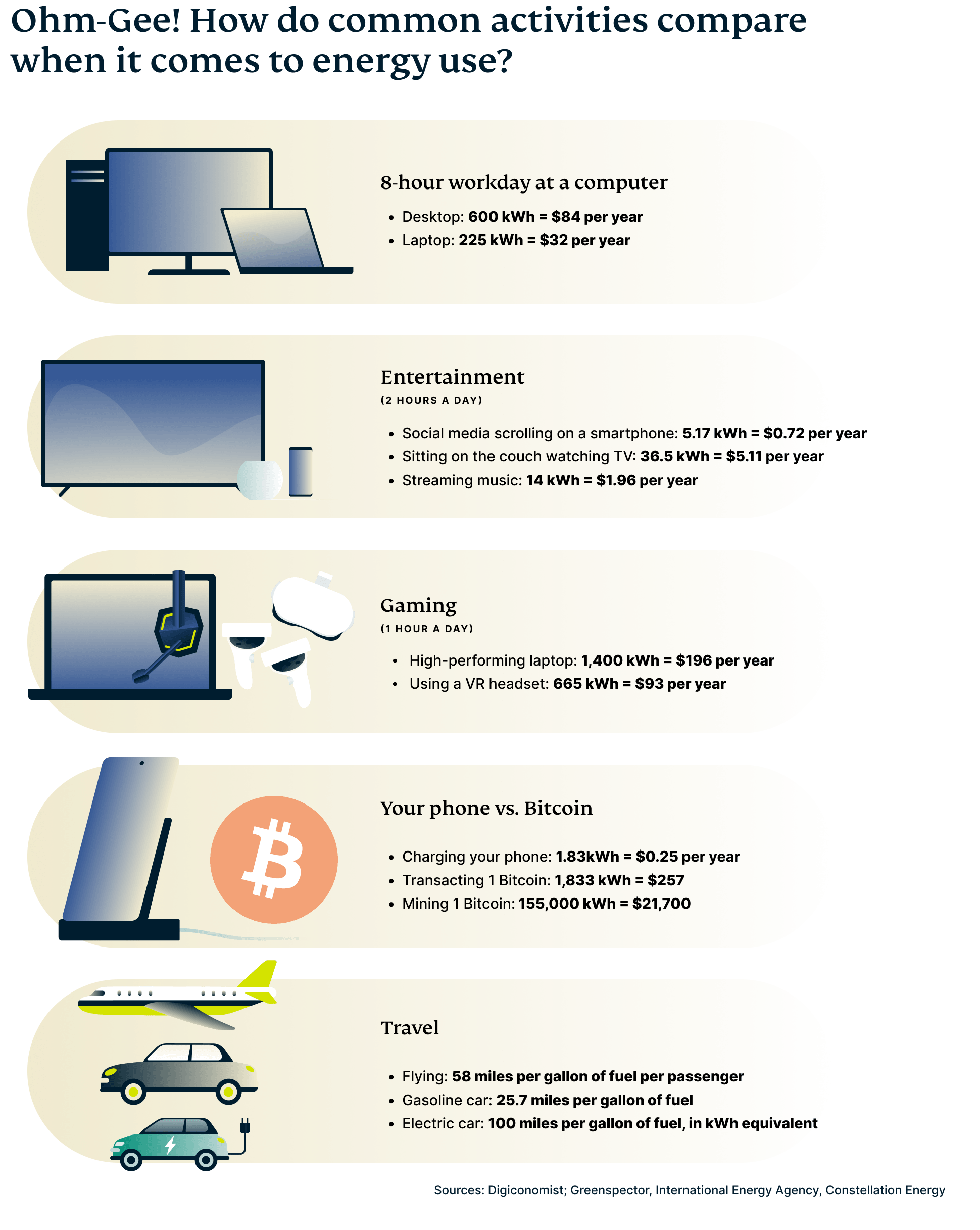
Is your work costing you more than you think?
If you’re stuck at a desk for eight hours a day, you might want to consider how your computer is impacting your energy usage. According to our calculations, using a desktop computer for eight hours a day consumes a whopping 600 kWh per year, which could ultimately be costing your company roughly 84 USD in energy use per employee.
In contrast, using a laptop for the same amount of time consumes only 225 kWh per year, costing just 32 USD in energy.
The energy costs of being entertained
Spending two hours a day on TikTok on your phone for a year only uses 5.17 kWh, which is less than what it costs to buy a cup of coffee these days. In comparison, binge-watching your favorite show for the same amount of time each day on a streaming platform like Netflix can consume up to 36.5 kWh per year, which adds up pretty fast. So, if you want to save some energy (and some cash), perhaps consider swapping your TV time for some social media scrolling.
In terms of music streaming, listening to your favorite playlist on Apple Music for an hour only uses 0.016 kWh, which isn’t much. Spending two hours a day streaming music for a year only uses approximately 14 kWh, which is around 1.96 USD worth of energy annually.
Power up: Energy use while gaming
Gaming can be an energy-intensive hobby, but have you ever wondered which setup is more efficient: a high-performance gaming laptop or a VR headset?
A gaming laptop can suck up between 300-500 watts of power, which means it consumes up to 1,400 kWh annually, costing you a whopping 196 USD a year in energy bills. In contrast, strapping on a VR headset for an hour of gaming (like the PlayStation VR headset) only uses 665 kWh per year which costs 93 USD annually, which is less than half the cost.
If you're looking to game with a cleaner conscience (and a fatter wallet), it might be time to ditch the high-performing laptop and go for a more energy-efficient route instead, without sacrificing your gameplay. By pairing your energy-efficient gaming setup with a gaming VPN, you can also optimize your gaming experience while keeping your connection secure and reducing lag.
From phones to Bitcoins
It's no secret that cryptocurrency mining requires a lot of energy. In fact, even the most efficient Bitcoin mining operation uses roughly 155,000 kWh to mine a single Bitcoin (which would cost you roughly 21,700 USD in energy bills). The New York Times equated the power consumed for Bitcoin mining annually to the total electricity used by Finland in one year.
But even Bitcoin transactions have an outsized energy cost. Sending or receiving a single Bitcoin requires a whopping 1,833 kWh (257 USD) of energy. It's worth noting that a Bitcoin is valued at 27,400 USD at the time of writing, which explains why people would spend that amount of energy to trade.
For comparison, charging your phone for a whole year only uses 1.83 kWh, which is equivalent to 0.25 USD. To put this in perspective, it would take you over 1,000 years of charging your phone to meet the energy equivalent of transacting a single Bitcoin. This equates to roughly a million times more in carbon emissions than a single credit card transaction.
So, if you trade crypto, it's going to be the largest contributor to your carbon footprint no matter what you do. Hopefully, in the future, more environmentally friendly mining methods will be developed and achieve popularity quickly, replacing these practices entirely.
Flights vs. driving
Driving a car, an electric car, or flying? If you're eco-conscious, you might be curious about which is more energy-efficient. Let's look at the numbers.
According to the EPA, every gallon of gasoline is equivalent to 33.7 kilowatt-hours (kWh) of electricity. Driving a conventional car 120 miles would consume approximately 158kWh. By comparison, an electric car using 2.9 miles per kWh brings the energy consumption to 41.3 kWh.
Newer electric car models, like the Tesla 3, boast a 4 kWh usage rate, allowing drivers to utilize 30 kWh worth of power per 120 miles, ultimately reducing energy use further.
On the flip side, there are also concerns about the high amounts of energy required to manufacture EV batteries. But overall, agencies like the EPA still consider electric vehicles to be more environmentally friendly than gasoline cars.
So, how does flying compare?
The efficiency of a flight depends on a lot of factors, including the age and weight of the plane, the number of passengers onboard, and the length of the flight. Recent statistics from U.S. airlines put average fuel consumption at 58 miles per gallon per passenger—which is more efficient than the average car efficiency of 25.7 miles per gallon.
But if you have multiple people traveling together in a car, you’re expending less gas per person though, which could mean lower energy consumption per passenger than flying in a plane.
Can individuals make a difference?
You’re probably wondering how much of a difference small changes in your individual energy consumption can really make to the planet. The fact is, actions on a corporate level or changes in government policies have a much greater impact than what individuals can achieve.
That said, our small habits in daily routines do add up. For example, let’s look at something as simple as sending an email.
While one email with an attachment uses a minuscule amount of electricity (0.00000225 kWh), if you consider that around 319.6 billion emails are sent each day, the amount of energy being used adds up to a whopping 215,730 kWh per day—that’s enough to power 20 average American homes for a year.
Watching a bit of YouTube seems harmless enough, but on a global level, the amount of energy consumed by YouTube viewership in one week can power some small countries (like Azerbaijan and Ecuador) for a year. Here is a look at various territories and how much of their annual energy consumption is equivalent to one week of YouTube use around the world.
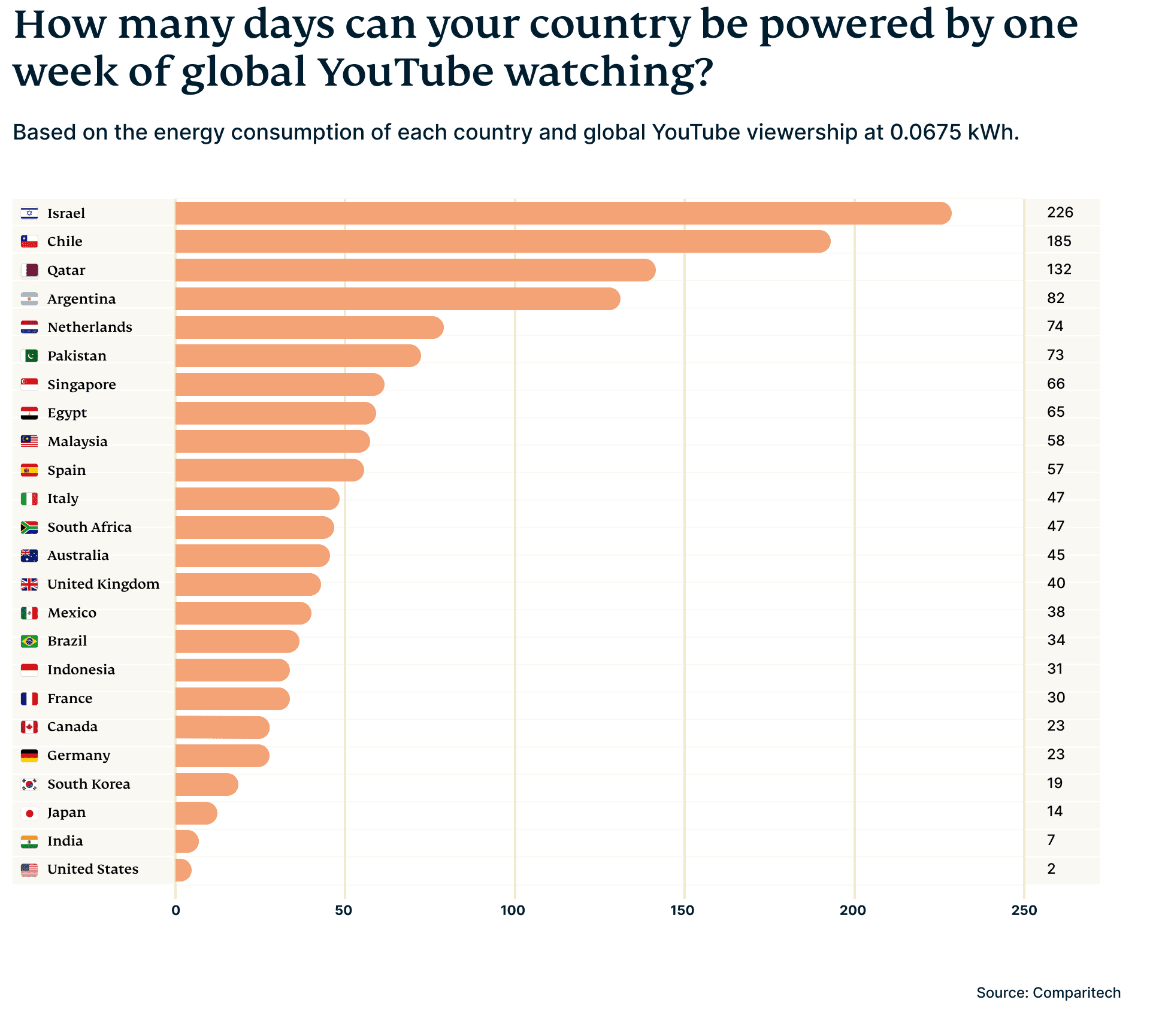
Watching YouTube videos in 4K uses 25% more energy than, say, streaming Netflix in UHD. With over one billion hours of YouTube videos watched daily, that's a lot of energy consumption. If no one watched YouTube for a week, it could generate a maximum energy output that would provide more than 36% worth of non-renewable electricity for Qatar over a year or 0.8% worth of electricity for the U.S.
What steps will you be taking in your everyday life to save energy? Let us know in the comments below.
Take the first step to protect yourself online. Try ExpressVPN risk-free.
Get ExpressVPN







